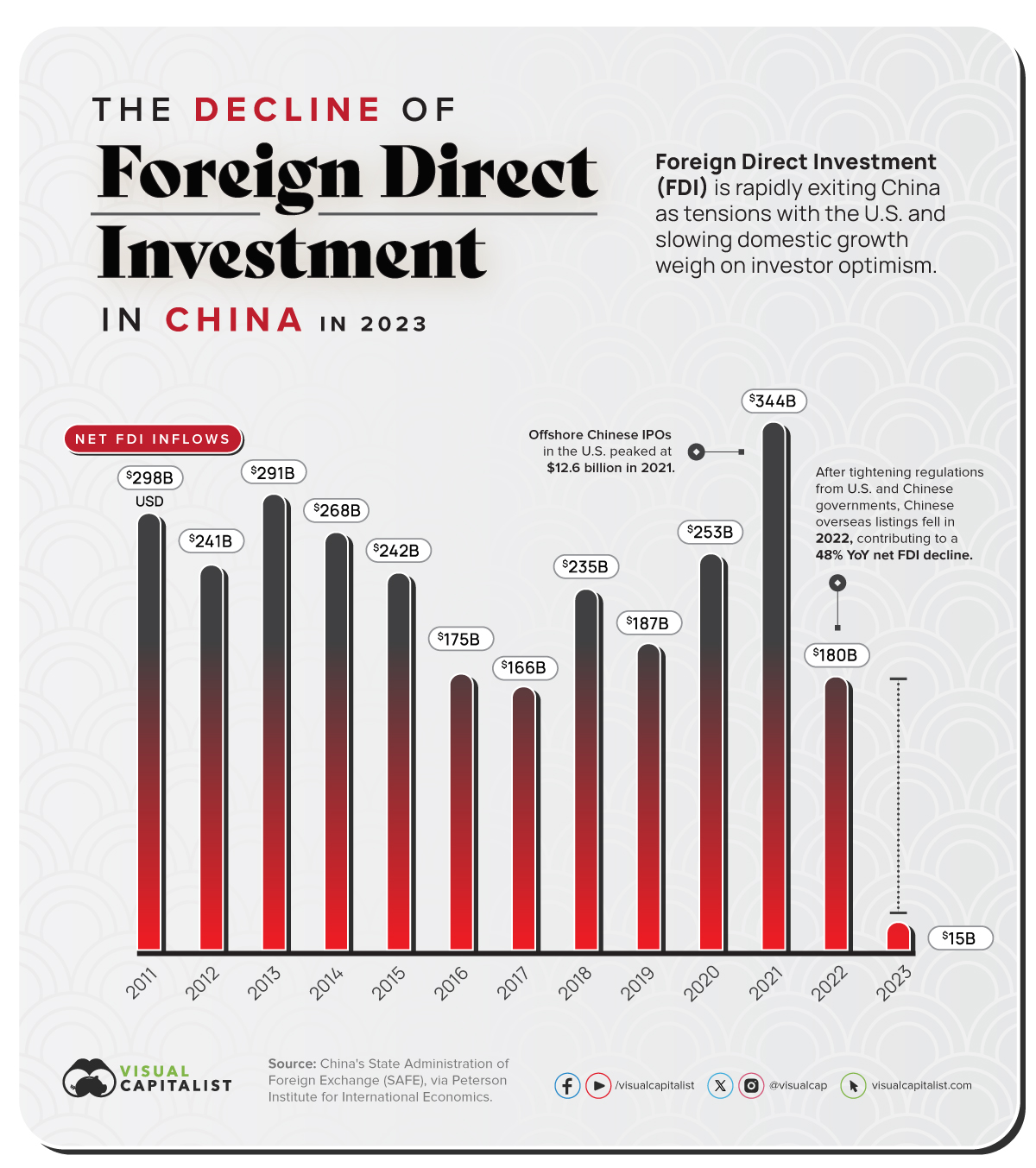![]()
See this visualization first on the Voronoi app.

Charted: Chinese FDI Inflows Hit Multi-Year Lows
This was originally posted on our Voronoi app. Download the app for free on iOS or Android and discover incredible data-driven charts from a variety of trusted sources.
The Chinese economy has thrown up several red flags in 2023 and now foreign investors are losing confidence in the world’s second-largest economy.
Data accessed via the Peterson Institute for International Economics and sourced from China’s State Administration of Foreign Exchange (SAFE) shows foreign direct investment (FDI) inflows have hit multi-year lows.
FDI occurs when an investor in one country acquires significant and lasting financial interest in a foreign enterprise. This data includes the IPO value of Chinese companies in foreign markets.
Foreign Investors Hit “Sell” on China in 2023
Aside from a broadly slowing economy, the Peterson Institute’s analysis highlights other key reasons why FDI inflows have scaled back so dramatically this year.
Firstly, geopolitical tensions (in the form of an escalating chip war) between the U.S. and China are worrying foreign investors—many of them American-headquartered companies with a presence in China, holding back on investments in local companies.
Secondly, the closure of due diligence firms (which allow foreign investors to make informed decisions on Chinese companies) along with a new national security law aimed at restricting cross-border data flows have disincentivized foreign investors from betting big if they wanted to.
| Year | FDI Inflows | YoY Change |
|---|---|---|
| 2011 | $280B | N/A |
| 2012 | $241B | -13.93% |
| 2013 | $291B | +20.75% |
| 2014 | $268B | -7.90% |
| 2015 | $242B | -9.70% |
| 2016 | $175B | -27.69% |
| 2017 | $166B | -5.14% |
| 2018 | $235B | +41.57% |
| 2019 | $187B | -20.43% |
| 2020 | $253B | +35.29% |
| 2021 | $344B | +35.97% |
| 2022 | $180B | -47.67% |
| 2023 Q1-Q3 |
$15B | -91.67% |
Meanwhile, huge spikes in FDI inflows between 2018 and 2021 indicate the success of Chinese companies listing on American securities exchanges, which SAFE includes in its data. However, crackdowns from both Chinese and U.S. securities regulators in 2022 turned the tap off briefly. Despite the restrictions being since removed, new listings have not bounced back.
Another Red Flag for the Chinese Economy
The Peterson Institute’s comparison of gross and net FDI flows found a nearly $100 billion shortfall—which means foreign firms are selling their Chinese investments, adding yet another red flag for the economy.
This slowdown is now having a ripple effect across the region—for Japan, South Korea, and Thailand’s economies—whose export sectors rely on substantial Chinese demand. Nations in sub-saharan Africa will also feel the pinch as Chinese sovereign lending continues to fall, already past the lowest it’s been in two decades.
Meanwhile, on a broader scale, Chinese growth contributes to one-third of world economic growth, which means the global economy will miss growth projections made last year—when economists had a more optimistic view of the world’s second-largest economy.
The post Charted: Chinese FDI Inflows Hit Multi-Year Lows appeared first on Visual Capitalist.